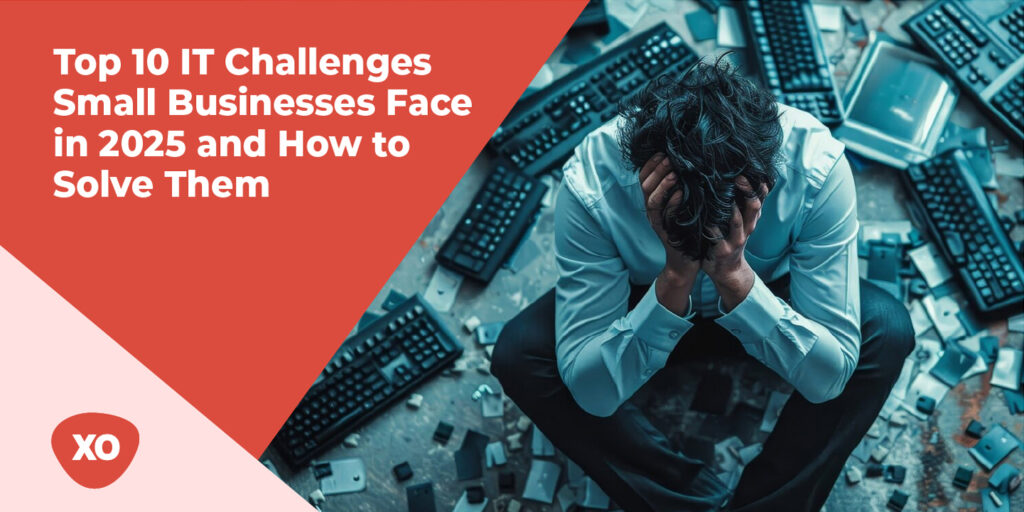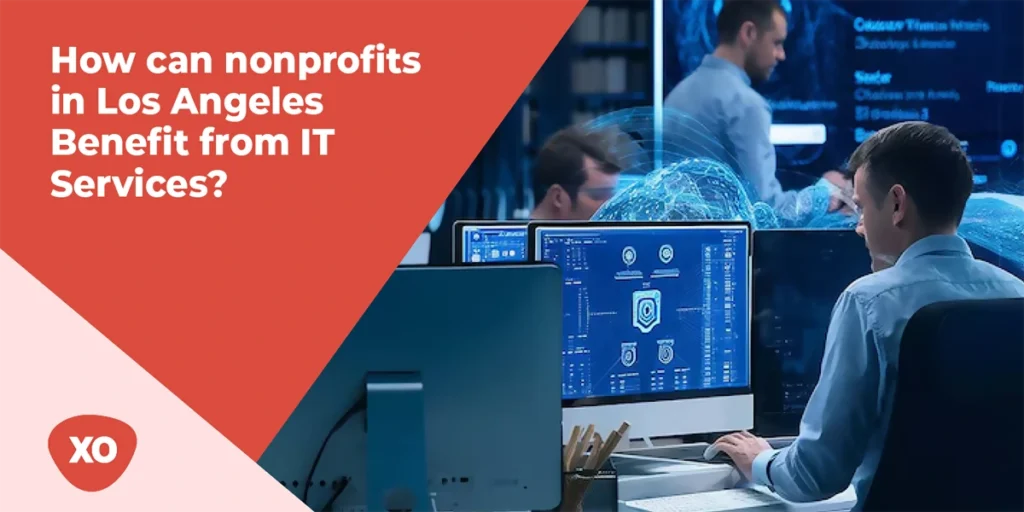Small businesses in 2025 are operating in a more complex digital environment than ever before. The shift to hybrid and remote work, the increasing risk of cyberattacks, and the pressure to scale efficiently have transformed IT from a back-office function into a strategic pillar. According to Verizon’s latest small business tech survey, 65% of SMBs plan to increase their IT budgets in 2025. This surge in spending reflects a growing realization: businesses can no longer afford to treat IT as an afterthought.
In this report, we break down the latest 2025 IT Services Industry Statistics, uncovering where small businesses are focusing their investments, what challenges they’re facing, and what they now expect from their IT partners. Whether you’re a business owner or an IT provider, these insights will help you stay competitive and prepared.
The IT Services Landscape for SMBs in 2025
- 33 million SMBs in the U.S., over 400 million globally.
- Only 43% of SMBs have in-house IT staff; the rest rely on MSPs and contractors.
- Co-managed and remote-first IT support models are rising.
- Hybrid work is pushing demand for scalable, secure, and cost-efficient IT services.
- Strong MSP Industry Growth 2025 is being driven by increased outsourcing and digital transformation needs.
Where Small Businesses Are Spending Their IT Budgets
Average annual IT spend per employee: $6,000 – $10,000
IT budgets as % of operating expenses: 6% to 12%
Top Spending Categories:
- Cybersecurity: 49% of SMBs increased their cybersecurity budget in the past year.
- MFA, firewalls, EDR tools, backup, disaster recovery
- Growing relevance of Cybersecurity Services Statistics in 2025 across industries
- Cloud infrastructure: Major shift from legacy systems to scalable cloud services.
- Supports trends shown in Cloud Services Market Insights from 2025
- Helpdesk & support: High demand in businesses with little/no internal IT staff.
- Collaboration tools: Microsoft Teams, Slack, Zoom gaining traction.
- Compliance & data backup: Especially in regulated industries like healthcare and legal.
These allocations reflect patterns found in recent IT Outsourcing Statistics for 2025, showing SMBs favoring flexibility and resilience.
Visual Idea: Bar graph comparing % of budget by category.
Spending Patterns & Budgets
Average IT budgets by industry:
- In 2025, healthcare organizations are projected to spend over $10,000 per employee, driven by stringent compliance requirements like HIPAA and the growing adoption of electronic health records (EHR) systems.
- Retailers are expected to allocate around $5,000–$8,000 per employee, focusing on customer experience tech, inventory automation, and omnichannel strategies.
- Manufacturing firms are predicted to spend between $6,500–$9,000, with investments going toward smart factory initiatives, IoT integration, and ERP upgrades.
Enterprise vs. SMB IT Spending Growth:
- Enterprises are forecast to increase their IT spending by 9% YoY in 2025, mainly on AI enablement, cybersecurity modernization, and hybrid work infrastructure.
- However, SMBs are showing an even more aggressive trajectory, with a 12% YoY growth in IT budgets. This reflects a broader trend where SMBs are scaling digital operations, investing in managed IT services, and leveraging affordable SaaS platforms to remain competitive.
- The SMB IT Services Market in 2025 is becoming increasingly lucrative, with many smaller firms allocating larger shares of their revenue to IT to catch up with enterprise capabilities.
Budget Allocation Breakdown (Average Across SMBs in 2025):
- Cybersecurity (30%): The rise of ransomware and regulatory fines has made cybersecurity the top budget priority. SMBs are investing in MDR services, zero-trust architecture, and employee training.
- Cloud Infrastructure (25%): As cloud-native apps dominate and remote work persists, cloud spending continues to rise. Spending is going toward multi-cloud environments, SaaS platforms, and disaster recovery-as-a-service (DRaaS).
- IT Support (20%): Reliable support services are key to maintaining uptime. Businesses are increasingly turning to MSPs to get 24/7 helpdesk coverage and proactive maintenance.
- On-prem Infrastructure (15%): While cloud adoption is growing, many firms retain critical legacy systems on-prem. Budget here supports network hardware, local servers, and hybrid infrastructure.
- Compliance & Backup (10%): Regulatory compliance and data recovery remain vital. Spending is directed at automated compliance monitoring tools, offsite backups, and archiving solutions.
These trends tie into broader 2025 IT Services Industry Statistics, reflecting a dynamic environment where businesses are reallocating resources to maximize agility, resilience, and long-term ROI. These shifts are also influenced by Cloud Services Market Insights for 2025 and also Cybersecurity Services Statistics, both of which show how integral these areas are to overall IT strategy.
Top Tech Challenges for SMBs in 2025
- Cybersecurity Threats:
- 70% of SMBs feel unprepared for a major cyberattack.
- 300% increase in SMB-targeted cybercrime since 2020.
- Cost of a data breach: $120,000 – $1.5M
- Limited internal expertise:
- Lack of skilled in-house IT teams slows response time and innovation.
- Tech adoption pace:
- Difficulty keeping up with rapid software/hardware cycles.
- Managing hybrid teams:
- Secure access, device management, collaboration across time zones.
- Aging infrastructure:
- Many SMBs still operate on outdated hardware/software.
These hurdles underscore the insights uncovered in IT Support Industry Data for 2025, reinforcing the need for agile support models.
Visual Idea: Infographic listing top 5 tech challenges with icons.
Industry-Specific IT Services Insights
Each industry continues to evolve with distinct IT demands shaped by compliance mandates, customer expectations, and operational complexity. According to leading IT Support Industry Data from 2025, sector-specific needs are increasingly influencing both technology selection and budget priorities.
- Healthcare: The healthcare sector remains one of the top spenders on IT services, with continued investments in HIPAA-compliant cloud infrastructure, electronic health records (EHR) systems, and endpoint protection across provider devices. As patient data becomes more decentralized, the focus has shifted to secure telehealth platforms, encrypted data sharing, and zero-trust access models. Spending is also being driven by the growing demand for AI-based diagnostic tools and predictive analytics platforms to improve care outcomes.
- Cannabis & Retail: These industries are prioritizing point-of-sale (POS) system security, real-time inventory management, and video surveillance systems to meet both compliance and customer experience goals. In the cannabis industry specifically, complex and evolving regulations around traceability and data retention have made managed IT services a critical partner in day-to-day operations. Retailers are also adopting omni-channel solutions and integrating loyalty platforms, supported by secure APIs and robust IT infrastructure, to streamline customer journeys. According to recent Managed IT Services Trends from 2025, cannabis retailers are among the fastest-growing adopters of integrated IT and security platforms.
- Government & Public Sector: Government agencies and public service organizations are accelerating their shift to the cloud, investing in FedRAMP-authorized solutions, CJIS-compliant data systems, and identity access management (IAM) tools. With citizen data privacy under constant scrutiny, there’s a strong push for data sovereignty, insider threat detection, and cyber risk assessments. The public sector is also leaning on IT consulting firms to modernize legacy infrastructure, improve service delivery, and enhance cybersecurity posture; trends that are consistent with broader IT Consulting Market Trends in 2025.
Compliance & Security Challenges by Sector:
- Healthcare: Compliance with HIPAA and HITECH remains paramount. Providers are deploying advanced logging systems, access controls, and audit-ready documentation tools to mitigate breach risks. There’s also a significant uptick in demand for cybersecurity awareness training, endpoint encryption, and third-party risk management, as highlighted by recent Cybersecurity Services Statistics for 2025.
- Retail & Cannabis: The primary concerns revolve around PCI DSS compliance, especially for payment systems, and camera footage retention laws, which vary by region and often require secure offsite backups. As physical and digital security converge, more retailers are turning to unified systems that combine access control, surveillance, and IT monitoring for full compliance visibility.
- Government: With national infrastructure increasingly digitized, public sector IT teams are prioritizing data residency laws, strict user access governance, and insider threat mitigation protocols. There’s a heavy reliance on automation and AI-powered security tools to preempt and contain cyber incidents, reflecting the broader priorities outlined in the 2025 IT Services Industry Statistics.
Cybersecurity Pressures Are Mounting
- MFA adoption: Only 20-30% of SMBs use multi-factor authentication.
- Cyber insurance: Just 17% of SMBs are insured against breaches.
- EDR adoption: Growing, but still inconsistent.
- Backup plans: Common but often poorly maintained.
Urgent Takeaway: Proactive security is now essential. Reactive protection is too costly.
These findings are consistent with broader Cybersecurity Services Statistics for 2025 highlighting the risk gap among small businesses.
Visual Idea: Pie chart showing cybersecurity adoption rates.
Outsourcing & Managed Services Data
Outsourcing Prevalence:
As of 2025, 68% of SMBs outsource at least one IT function, a significant rise from 54% in 2020, according to recent IT Outsourcing Statistics from 2025. This upward trend reflects the growing pressure on small businesses to modernize without overextending limited internal resources. Outsourcing is now seen not just as a cost-saving measure, but as a strategic move to gain access to enterprise-grade technology and support.
Top Outsourced Functions in 2025:
- Helpdesk & Support (70%): With hybrid work environments and limited internal staff, most SMBs now outsource IT helpdesk functions to ensure round-the-clock availability and rapid issue resolution.
- Cybersecurity Management (63%): Due to increasing cyber threats and compliance obligations, SMBs are leaning heavily on MSPs for managed detection and response (MDR), firewall management, and vulnerability assessments.
- Cloud Infrastructure Management (58%): As businesses shift from legacy systems to cloud platforms, outsourcing cloud operations, including configuration, monitoring, and optimization, has become a norm.
Emerging Outsourcing Areas:
- Compliance Management: Especially in sectors like healthcare, cannabis, and finance, SMBs are now outsourcing compliance reporting, documentation, and monitoring to third-party experts.
- IT Strategy & Virtual CIO Services: Many SMBs are leveraging fractional CIOs or vCISOs via their MSPs to access executive-level IT planning without the full-time expense.
Benefits of Outsourcing for SMBs:
- Cost Savings: On average, businesses report 25–40% savings when outsourcing versus hiring equivalent in-house teams. This is especially significant for startups and growing firms.
- 24/7 Monitoring & Support: Most MSPs now provide continuous threat monitoring, real-time alerts, and proactive support, something that most SMBs can’t replicate internally.
- Scalability & Flexibility: Outsourced services allow businesses to scale up or down quickly in response to growth, seasonal demands, or shifts in market focus.
- Access to Specialized Expertise: Partnering with MSPs ensures SMBs can access specialists in areas like cloud migration, cybersecurity, or compliance without lengthy hiring processes.
The accelerated MSP Industry Growth in 2025 is closely tied to these trends. With rising expectations around uptime, security, and compliance, outsourcing enables SMBs to keep pace with enterprise IT standards without the associated costs or staffing burdens. It also reflects broader developments across the SMB IT Services Market in 2025, where agility and operational efficiency are paramount.
What SMBs Expect from Their IT Providers
- Fast response: Minutes, not hours or days.
- Proactive service: Fix issues before they affect operations.
- Tailored solutions: Not one-size-fits-all.
- Transparent pricing: No hidden fees.
- Strategic advice: Rise of fractional CIOs and vCISOs.
Stat Highlight: 56% of SMBs have switched providers due to poor responsiveness.
These shifts align with broader IT Consulting Market Trends from 2025 as SMBs seek business-aligned support models.
Looking Ahead: Trends That Will Define the Future
- AI adoption:
- 75% of SMBs will use at least one AI-powered IT tool by 2026.
- Uses: automated support tickets, system monitoring, security alerts.
- Automation:
- Self-healing systems
- Automated compliance reporting
- Hybrid cloud becomes standard.
- Compliance-as-a-Service rises as regulations tighten.
- Specialized IT providers will serve niche industries (cannabis, legal, healthcare, retail).
These changes are shaping the landscape as supported by Managed IT Services Trends from 2025 and redefining long-term strategies in the SMB IT Services Market in 2025.
Visual Idea: Timeline of upcoming trends covering a period of 2-3 years (2025 to 2027).
The XO Team’s Perspective
At XO, we’ve seen firsthand how proactive IT planning saves businesses time, money, and stress. Many SMBs come to us after years of reactive support, only reaching out when something breaks. Unfortunately, by the time they realize the gaps in their security or infrastructure, the damage has already been done.
We commonly spot red flags like missing cybersecurity essentials (such as MFA and antivirus), outdated hardware running unsupported operating systems, and vendors who rarely communicate outside of invoices. Our goal is to change that dynamic. By providing comprehensive assessments, tailored roadmaps, and fast, transparent support, we help SMBs not just survive but thrive.
Summary & Takeaways
- 65% of SMBs will increase their IT spend in 2025
- MSP usage is growing rapidly, with 43% outsourcing at least some IT
- Cybersecurity is the top investment category
- Only 20–30% of SMBs have MFA enabled
- AI and hybrid cloud will define the next phase of IT services
For small businesses, now is the time to assess IT health and align strategy with long-term goals. The gap between proactive and reactive IT is widening. Make sure you’re on the right side.
Want to see how your IT setup stacks up against 2025’s standards? Download our Free 2025 SMB IT Checklist. Get a Complimentary IT Health Check from XO. Schedule a Free Consultation today and plan out your IT roadmap.




